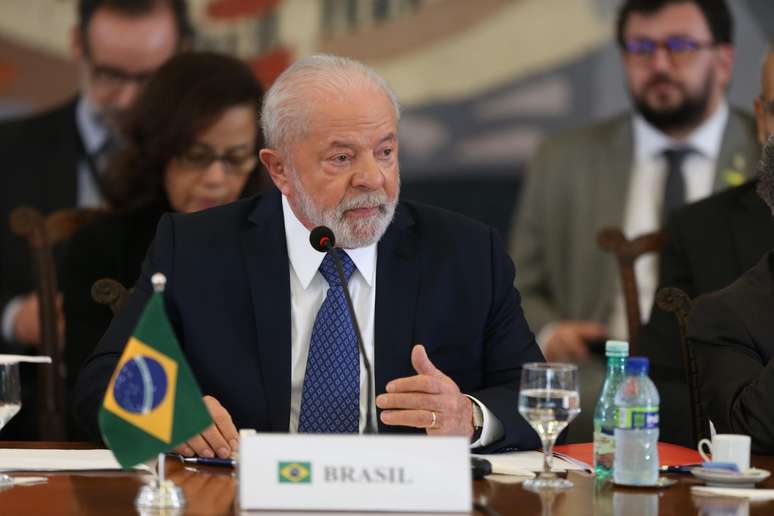In line with repeated public challenges to the dominance of the dollar in global financial transactions, Lula has suggested the adoption of a common currency in the region
OR President Luiz Inácio Lula da Silva (PT) proposed this Tuesday, 30, at Summit of South American countries sponsored by Brazil the creation of a common currency for commercial purposes among the 12 countries of South America.
In line with repeated public protests of the dominance of the dollar in global financial transactions, Lula has suggested the adoption of a common currency in the region, opening the “retreat” of South American presidents, which he promoted in Brasilia.
The purpose of the meeting is to promote new forms of continental integration and permanent dialogue between the presidents.
Lula made a number of proposals, including creating “a common reference unit for trade, reducing dependence on extra-regional currencies.”
According to the PT, the initiative would be a way to “deepen our South American identity also in the monetary area”. He also floated the idea that countries have more efficient compensation mechanisms.
Lula’s proposal is not to change the real or national currencies of other countries, which are commonly used by the population, but to establish one only for payments on imports and exports.
The idea has been mooted due to the dollar shortage and the trade impacts of the monetary policy of major trading partners, such as Argentina.
The president also discussed adopting a common currency between Brazil and Argentina during a visit to the country in January. The two countries have already established the basis for operations like this in the past, but the mechanism has not taken off.
On recent trips to Japan and China, Lula has questioned head-on the dominance of the dollar as the most internationally accepted currency. Washington does not like the content of the speech, and is echoed by Beijing and Moscow, rival powers of the United States, the only country that issues the currency.
Lula has already declared that he is “dreaming” of the creation of a foreign trade currency like the euro by the European Union by the BRICS countries. He said he hopes to see this discussion moving forward in the New Development Bank, a financial institution set up by Brazil, Russia, India, China and South Africa.
In addition, this year the central banks of Brazil and China began to cooperate so that trade and investment between the two can be done bypassing the use of the dollar, directly from the real to the yuan, through clearing houses, without the need to exchange currencies for US money.
The Brazilian president has made a total of ten proposals to his South American peers. In addition to the common currency, Lula:
- He presented the resumption of Unasur (Union of South American Nations), a dialogue mechanism abandoned since 2014 due to political differences, which he lacks. Only seven countries are still part of it: Brazil, Argentina, Peru, Bolivia, Venezuela, Guyana and Suriname. He said, however, that the rule of decisions made by consensus should be made more flexible, so that they can advance by majority vote.
- Lula wants all presidents to nominate a trusted representative to form a dialogue committee in order to make decisions, within a period of 120 days, on the proposals discussed on Tuesday. Called the High Level Group, this commission of presidential advisers should “present a road map for the integration of South America”.
Resumption of Unasur
In his speech, Lula highlighted the country’s willingness to resume instruments of regional integration, such as the Union of South American Nations (Unasur) and the Community of Latin American and Caribbean States (CELAC).
“South America has before it, once again, the possibility of following the path of union. And I don’t need to start over. Unasur is a collective good. Let’s remember that it is in force, seven countries are still full. It is It’s important to get the building process back on track, but in doing so it’s essential to critically evaluate what has gone wrong and account for transitions,” he said.
Lula also said that it is necessary to overcome the divisions of recent times. “In the region, we let ideologies divide us and interrupt the integration effort. We have abandoned the channels of dialogue and the mechanisms of cooperation and, with that, we have lost everyone,” she said. “We understand that integration is essential to strengthen Latin America. A strong, confident and politically organized South America broadens the possibilities for asserting a true Latin American and Caribbean identity internationally.”
The presidents of the Argentina, Alberto Fernándezfrom the Bolivia, Louis MapleFrom Chile, Gabriel Boricfrom the Colombia, Gustav PeterFrom Ecuador, William Lassofrom Guyana, Irfaan Ali, from ParaguayMario Abdo Benítez, from Suriname, Chan Santokhi, from UruguayLuis Lacalle Pou, e Venezuela, Niccolo Maduro.
An exception is the president of Peru, Dina Boluarte, who sent the president of the Council of Ministers, Alberto Otárola, to the country. Dina took over the Peruvian government after Pedro Castillo was ousted for attempting a coup and, for constitutional reasons and in the midst of the local political crisis, she was unable to leave Peru.
In addition to the opening speech by Lula and the statements of all the heads of state. In the afternoon there will be informal talks in a small format: the presidents will be able to bring only their chancellor and, at most, two other advisers.
In the evening, delegations will attend a dinner hosted by Lula and First Lady Janja da Silva at the Alvorada Palace. According to the Ministry of Foreign Affairs, the idea of the summit is to be a sort of “retreat”, that is, to create the occasion for an informal dialogue, an exchange of ideas to resume the ties that have been strained in recent years.
Source: Terra
Rose James is a Gossipify movie and series reviewer known for her in-depth analysis and unique perspective on the latest releases. With a background in film studies, she provides engaging and informative reviews, and keeps readers up to date with industry trends and emerging talents.






